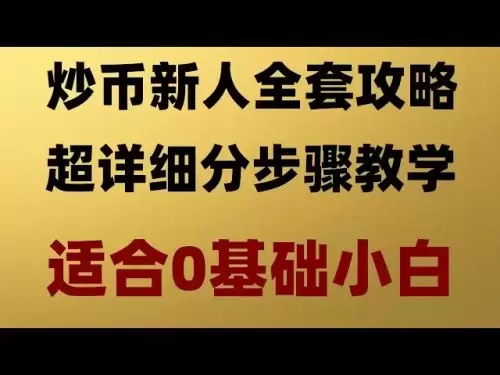-
 Bitcoin
Bitcoin $105,710.8981
0.27% -
 Ethereum
Ethereum $2,549.4669
0.63% -
 Tether USDt
Tether USDt $1.0005
-0.03% -
 XRP
XRP $2.1648
0.95% -
 BNB
BNB $648.0733
0.29% -
 Solana
Solana $152.9889
5.33% -
 USDC
USDC $1.0000
0.01% -
 Dogecoin
Dogecoin $0.1755
-1.51% -
 TRON
TRON $0.2737
1.10% -
 Cardano
Cardano $0.6333
1.23% -
 Hyperliquid
Hyperliquid $41.3018
2.55% -
 Sui
Sui $3.0035
1.58% -
 Bitcoin Cash
Bitcoin Cash $462.2886
6.65% -
 Chainlink
Chainlink $13.3062
0.76% -
 UNUS SED LEO
UNUS SED LEO $9.2657
1.74% -
 Stellar
Stellar $0.2584
0.72% -
 Avalanche
Avalanche $19.1006
0.74% -
 Toncoin
Toncoin $2.9682
0.37% -
 Shiba Inu
Shiba Inu $0.0...01201
-0.26% -
 Litecoin
Litecoin $86.3398
1.22% -
 Hedera
Hedera $0.1547
0.11% -
 Polkadot
Polkadot $3.8200
0.81% -
 Ethena USDe
Ethena USDe $1.0000
-0.05% -
 Monero
Monero $315.2846
0.98% -
 Dai
Dai $0.9998
-0.03% -
 Bitget Token
Bitget Token $4.5227
-0.14% -
 Pepe
Pepe $0.0...01109
0.94% -
 Pi
Pi $0.6036
-1.94% -
 Uniswap
Uniswap $7.1389
-3.72% -
 Aave
Aave $274.9972
-0.45%
Is it necessary to clear the position when the large-volume big Yin line falls below the 10-day line?
A large-volume big Yin line below the 10-day moving average signals strong selling pressure, prompting traders to consider exiting positions to manage risk and avoid further losses.
Jun 15, 2025 at 11:14 pm
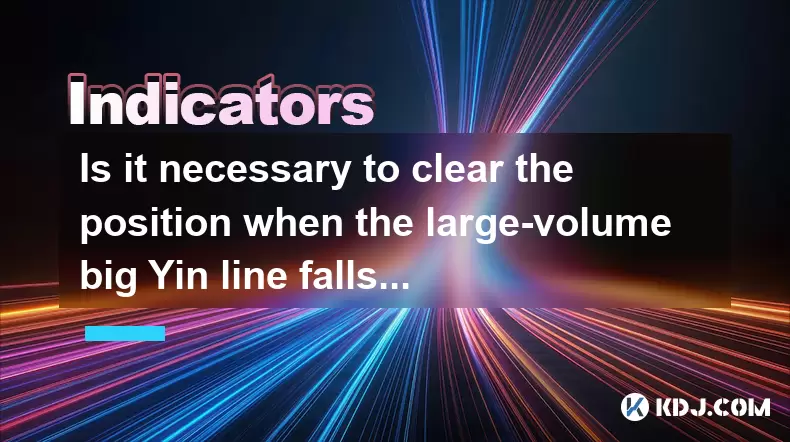
Understanding the 10-Day Moving Average in Cryptocurrency Trading
In cryptocurrency trading, the 10-day moving average is a commonly used technical indicator that helps traders identify short-term trends. It calculates the average price of an asset over the last ten days and smooths out price volatility. When prices fall below this line, especially with a large-volume big Yin line, it often signals strong selling pressure.
Traders should understand that the 10-day moving average acts as a dynamic support or resistance level. If the price consistently stays above it, it suggests a bullish trend. Conversely, when the price breaks below this level, particularly on high volume, it may indicate a reversal or continuation of a downtrend.
What Is a Large-Volume Big Yin Line?
A large-volume big Yin line refers to a candlestick pattern where the price closes significantly lower than its opening, accompanied by unusually high trading volume. This type of candlestick typically reflects panic selling, profit-taking, or institutional dumping. In crypto markets, which are highly volatile and sentiment-driven, such patterns can be powerful indicators of market psychology.
When a large-volume big Yin line occurs below the 10-day moving average, it reinforces bearish momentum. Traders often interpret this as a sign that sellers have taken control and that further downside movement may follow. However, context matters—this signal should not be viewed in isolation.
Why Do Traders Consider Closing Positions Under These Conditions?
Many traders opt to clear their positions when they observe a large-volume big Yin line falling below the 10-day moving average due to several reasons:
- Loss of Support: The 10-day line no longer serves as support once broken, suggesting the trend may continue downward.
- High Volume Confirmation: High volume accompanying the drop confirms strong selling interest, increasing the likelihood of further declines.
- Risk Management: Exiting early helps limit potential losses if the price continues to fall.
Some traders use stop-loss orders placed just below the 10-day moving average to automate this process. Others manually monitor the situation and decide based on additional indicators or chart patterns.
How to Analyze the Context Before Making a Decision
Before deciding whether to clear your position, consider the following factors:
- Market Trend: Is the overall trend bullish or bearish? A break below the 10-day line in a strong uptrend might be a temporary pullback rather than a reversal.
- Volume Analysis: Was the volume truly significant compared to the average volume over the past few weeks?
- Other Indicators: Check for confirmation from other tools like RSI, MACD, or Fibonacci retracement levels.
- News Events: Sometimes sharp drops are caused by sudden news events or regulatory changes. Understanding the cause behind the move is crucial.
By evaluating these aspects, traders can avoid knee-jerk reactions and make more informed decisions about whether to exit or hold their positions.
Step-by-Step Guide to Evaluating Your Position
If you're facing a large-volume big Yin line below the 10-day moving average and considering exiting, here’s a detailed step-by-step guide:
- Review the Chart: Zoom out to see the broader trend. Is the asset in a clear uptrend, downtrend, or sideways consolidation?
- Check Historical Behavior: Look at how the price reacted after similar candlesticks in the past.
- Analyze Volume: Compare the current volume with the previous 20 sessions to determine if it's abnormally high.
- Assess Risk-Reward Ratio: Calculate how much you stand to lose versus how much you could gain if the price recovers.
- Use Multiple Timeframes: Confirm the signal on higher timeframes (e.g., 4-hour or daily charts) to ensure consistency.
- Set Clear Exit Criteria: Decide whether you’ll exit entirely, partially hedge, or wait for a retest of the 10-day line.
This structured approach ensures that emotional bias doesn't cloud judgment and that decisions are made systematically.
Frequently Asked Questions
Q: Can a large-volume big Yin line ever be a buying opportunity?
Yes, in some cases, especially after a prolonged downtrend, a sharp sell-off with high volume can mark a bottom or capitulation point. Skilled traders look for signs of reversal such as engulfing patterns or oversold conditions on RSI before considering a long entry.
Q: What if the price quickly rebounds above the 10-day line after the big Yin line?
That could suggest that the breakdown was a false signal. Monitoring the next few candles and watching for a strong reversal candle or increased buying volume is key to reassessing the situation.
Q: Should I always close my position if the price drops below the 10-day moving average?
No, not necessarily. While it’s a useful tool, the 10-day line should be used in conjunction with other indicators and market context. Blindly exiting every time can lead to missed opportunities during healthy corrections within a larger uptrend.
Q: How does the behavior of Bitcoin affect altcoins in this scenario?
Bitcoin often sets the tone for the broader market. If Bitcoin shows a large Yin line below its 10-day line, altcoins may follow. However, some altcoins may behave differently based on their individual fundamentals or news. Always analyze each asset independently while keeping macro trends in mind.
Disclaimer:info@kdj.com
The information provided is not trading advice. kdj.com does not assume any responsibility for any investments made based on the information provided in this article. Cryptocurrencies are highly volatile and it is highly recommended that you invest with caution after thorough research!
If you believe that the content used on this website infringes your copyright, please contact us immediately (info@kdj.com) and we will delete it promptly.
- BitMEX Extends Its Zero-Fee Bitcoin Spot Trading Campaign Until BTC Hits $100k
- 2025-06-16 07:45:12
- Into 2025, artificial intelligence (AI) was supposed to be one of the biggest investment trends of the year for the crypto sector.
- 2025-06-16 07:45:12
- Bitcoin Solaris (BTC-S) Emerges as a Powerful New Challenger to Ethereum's DeFi Dominance
- 2025-06-16 07:40:18
- Bitcoin (BTC) Price Prediction: Market Cap Could Hit $2 Trillion by 2025
- 2025-06-16 07:40:18
- The 4 Hottest Crypto Presales to Ape Into in 2025
- 2025-06-16 07:35:13
- 5 Rare Dimes and a Bicentennial Quarter Worth Millions
- 2025-06-16 07:35:13
Related knowledge
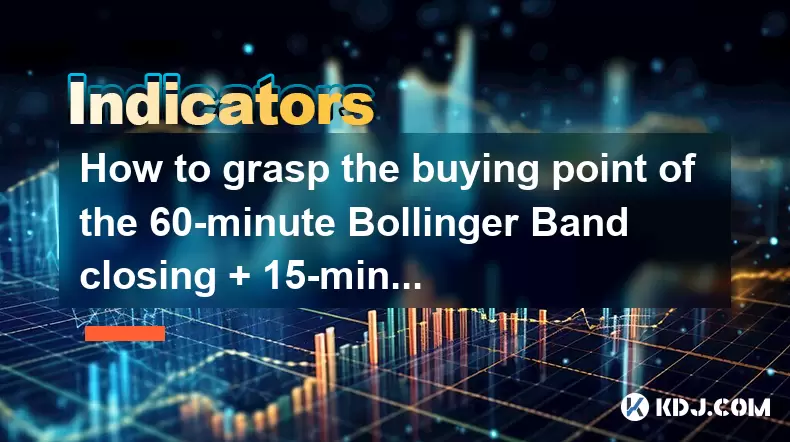
How to grasp the buying point of the 60-minute Bollinger Band closing + 15-minute MACD bottom divergence?
Jun 16,2025 at 12:03am
Understanding the Bollinger Band Closing Signal on a 60-Minute ChartThe Bollinger Band closing signal refers to a situation where the price closes outside the upper or lower band and then re-enters it in the subsequent candlestick. In this context, we focus on the lower Bollinger Band closing, which indicates a potential reversal from a downtrend. On th...
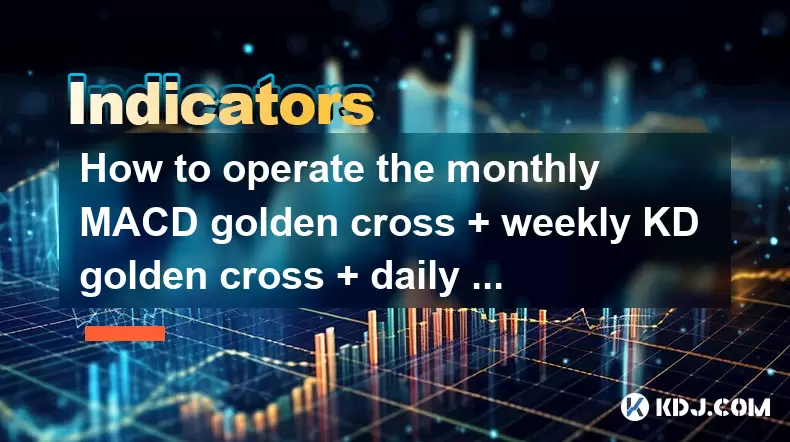
How to operate the monthly MACD golden cross + weekly KD golden cross + daily volume breakthrough?
Jun 15,2025 at 05:36am
Understanding the Strategy: Monthly MACD Golden CrossTo effectively operate the monthly MACD golden cross, traders must first understand what this signal entails. The MACD (Moving Average Convergence Divergence) golden cross occurs when the MACD line crosses above the signal line on a given chart timeframe. When this happens on the monthly chart, it sug...
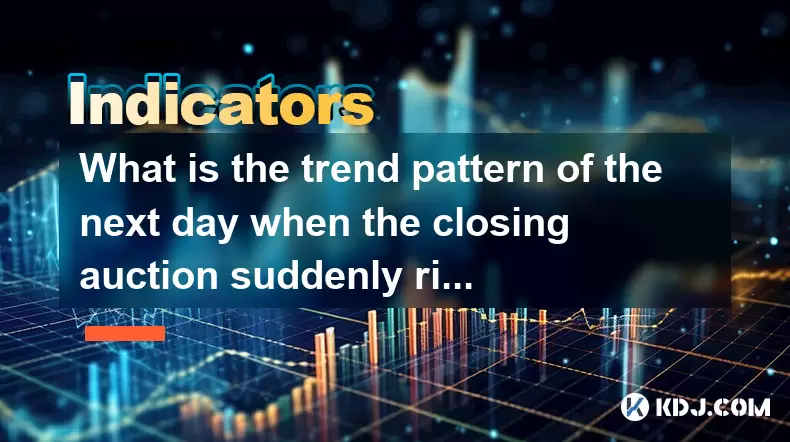
What is the trend pattern of the next day when the closing auction suddenly rises?
Jun 15,2025 at 08:15am
Understanding Closing Auctions in Cryptocurrency MarketsIn the context of cryptocurrency trading, a closing auction refers to a mechanism used by exchanges to determine the closing price of an asset at the end of a trading session. This process typically occurs within a short time window before the market closes for the day and aims to provide a fair an...

What does it mean when the volume fluctuates during the sideways trading at high levels?
Jun 15,2025 at 10:28am
Understanding Volume Fluctuations in Sideways TradingWhen volume fluctuates during sideways trading at high levels, it refers to the changes in the number of assets traded over a given period while the price remains relatively stable, moving within a defined range. This phenomenon typically occurs when the market lacks a clear directional bias—neither b...
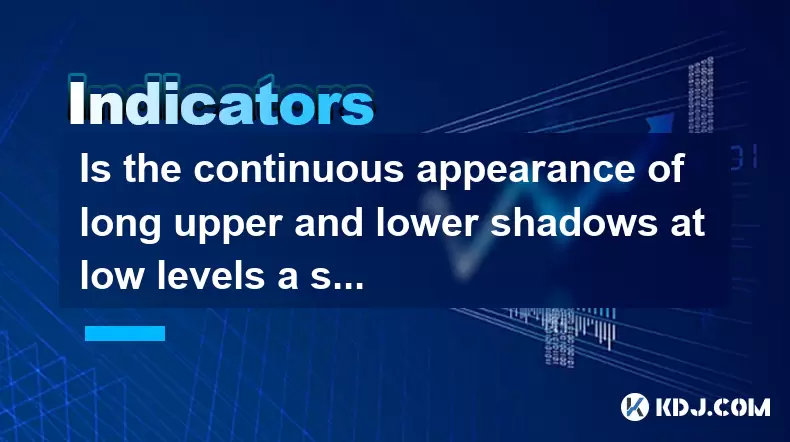
Is the continuous appearance of long upper and lower shadows at low levels a signal of accumulation?
Jun 15,2025 at 01:43am
Understanding Long Upper and Lower Shadows in Candlestick ChartsIn the world of cryptocurrency trading, candlestick patterns are widely used to analyze price movements. A long upper shadow, also known as a wick or tail, indicates that the price rose significantly during the period but was pushed back down by selling pressure. Conversely, a long lower sh...
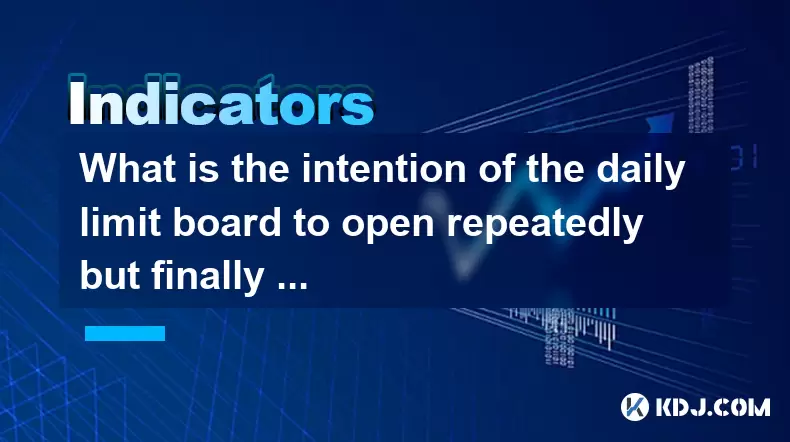
What is the intention of the daily limit board to open repeatedly but finally close?
Jun 15,2025 at 01:08am
Understanding the Daily Limit Board in Cryptocurrency TradingIn cryptocurrency trading, a daily limit board refers to a price movement restriction mechanism applied by certain exchanges or regulatory bodies. This mechanism is primarily used to prevent extreme volatility and panic selling or buying during periods of intense market fluctuation. When an as...

How to grasp the buying point of the 60-minute Bollinger Band closing + 15-minute MACD bottom divergence?
Jun 16,2025 at 12:03am
Understanding the Bollinger Band Closing Signal on a 60-Minute ChartThe Bollinger Band closing signal refers to a situation where the price closes outside the upper or lower band and then re-enters it in the subsequent candlestick. In this context, we focus on the lower Bollinger Band closing, which indicates a potential reversal from a downtrend. On th...

How to operate the monthly MACD golden cross + weekly KD golden cross + daily volume breakthrough?
Jun 15,2025 at 05:36am
Understanding the Strategy: Monthly MACD Golden CrossTo effectively operate the monthly MACD golden cross, traders must first understand what this signal entails. The MACD (Moving Average Convergence Divergence) golden cross occurs when the MACD line crosses above the signal line on a given chart timeframe. When this happens on the monthly chart, it sug...

What is the trend pattern of the next day when the closing auction suddenly rises?
Jun 15,2025 at 08:15am
Understanding Closing Auctions in Cryptocurrency MarketsIn the context of cryptocurrency trading, a closing auction refers to a mechanism used by exchanges to determine the closing price of an asset at the end of a trading session. This process typically occurs within a short time window before the market closes for the day and aims to provide a fair an...

What does it mean when the volume fluctuates during the sideways trading at high levels?
Jun 15,2025 at 10:28am
Understanding Volume Fluctuations in Sideways TradingWhen volume fluctuates during sideways trading at high levels, it refers to the changes in the number of assets traded over a given period while the price remains relatively stable, moving within a defined range. This phenomenon typically occurs when the market lacks a clear directional bias—neither b...

Is the continuous appearance of long upper and lower shadows at low levels a signal of accumulation?
Jun 15,2025 at 01:43am
Understanding Long Upper and Lower Shadows in Candlestick ChartsIn the world of cryptocurrency trading, candlestick patterns are widely used to analyze price movements. A long upper shadow, also known as a wick or tail, indicates that the price rose significantly during the period but was pushed back down by selling pressure. Conversely, a long lower sh...

What is the intention of the daily limit board to open repeatedly but finally close?
Jun 15,2025 at 01:08am
Understanding the Daily Limit Board in Cryptocurrency TradingIn cryptocurrency trading, a daily limit board refers to a price movement restriction mechanism applied by certain exchanges or regulatory bodies. This mechanism is primarily used to prevent extreme volatility and panic selling or buying during periods of intense market fluctuation. When an as...
See all articles





















